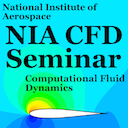96th NIA CFD Seminar
Topic: Hamiltonian-Strand (HAMSTR) Approach Using Hybrid Meshes for Aerodynamic Flow Analysis
Date: Tuesday, November 28, 2017
Time: 11am-noon (EST)
Room: NIA, Rm101
Speaker: Yong Su Jung
Speaker Bio: Yong Su Jung is a Ph.D candidate student in Aerospace Engineering department at the University of Maryland. He holds B.S (2012). and M.S (2014) in Aerospace Engineering from Korea Advanced Institute of Science and Technology. His research interests are in developing and applying Computational Fluid Dynamics methods for external flow simulations, such as rotary wing. His research has been funded by Department of Defense (DoD) HPCMP CREATE-AV program and Korea Aerospace Research Institute. He was a member of the University Maryland team received first place in the graduate category for 2016 AHS Design Competition.
Abstract: A solution framework using Hamiltonian paths and strand grids (HAMSTR) is presented for two and three-dimensional flows. The methodology can create a volume mesh starting from either an unstructured surface mesh comprised of mixed triangular-quadrilateral elements or a fully unstructured volume mesh. “Line structure” through the meshes are found in a robust manner and the flow solver uses line-implicit schemes and stencil-based discretization along these lines, similar to a structured grid flow solver. The framework has been developed mostly for rotorcraft CFD simulations, which requires robust mesh generation around complex geometry and efficient numerical method for large scale problems.
HAMSTR is a 3D compressible finite volume solver that can operate across multiple processors using MPI. Hybrid RANS/LES turbulence modeling based on the Spalart-Allmaras turbulence model and γ-〖Re〗_θ-SA laminar/turbulent transition model of Medida-Baeder are integrated into the solver for better predictions of the boundary layer and resulting flowfield as compared with a fully turbulent RANS simulation. Furthermore, deformable meshes can also be handled for elastic body simulations such as rotor blades. An overset technique (using TIOGA) allows for a hybrid mesh system, which consists of a near-body Hamiltonian/Strand grid and off-body Cartesian nested meshes. The integration framework between the various components of the code is performed using Python to allow for ease of integration to other codes in the research group. The current infrastructure is used to explore various cases ranging from simple representative geometries, such as 2D airfoil, to complex geometries such as rotating rotor hub and a full wind turbine. Some, CFD/CSD predictions for a slowed rotor are also studied.
Additional information, including the webcast link, can be found at the NIA CFD Seminar website:
